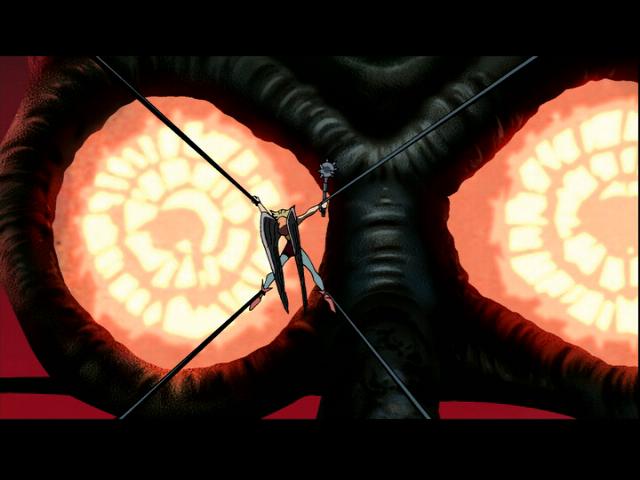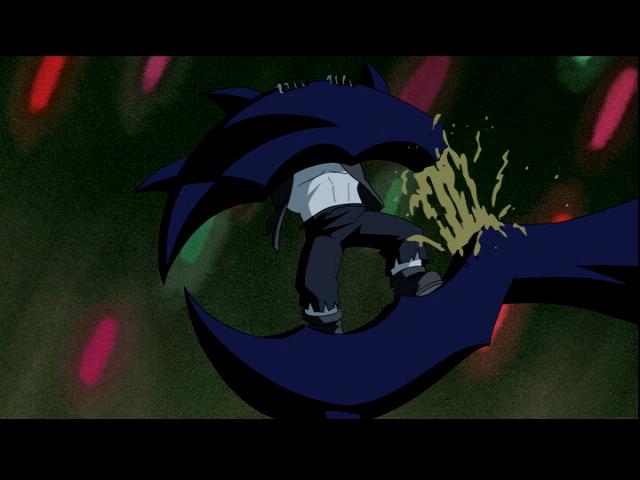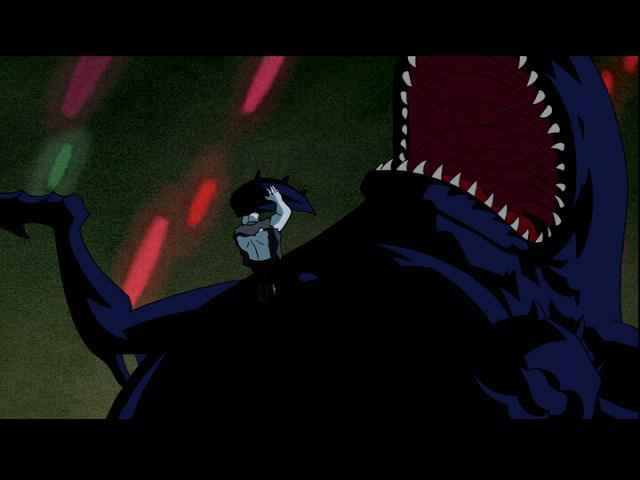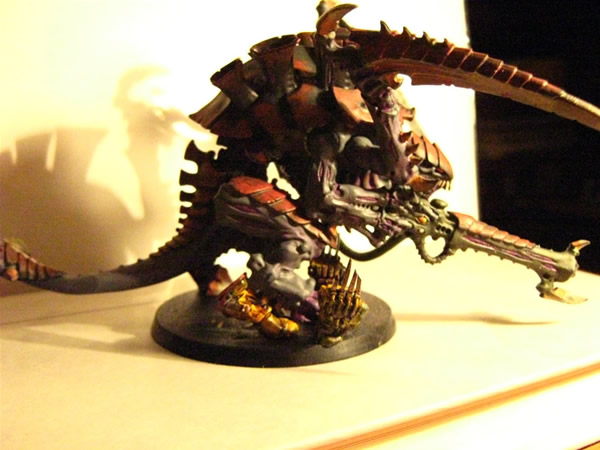Every now and then, I like to blow an afternoon reading at
TVtropes.org. They have an enormous collection of trite plot devices and characters that often show up in various media. I lavish a fair amount of love and attention on esoterica. In the extreme, it seems because even TVtropes doesn't have a precise fit for a trope that makes up some of my comfort reading.
I love the riddling trickster's tomb. I love tombs and crypts in which the setup and execution would have baffled NASA engineers, where the concealed 10 x 10 pit traps are still in perfect working condition after centuries, and even millennia.
There's a bit of my affection for ancient Egypt tied up in this. After all, the characters are pludering a trapped tomb, loading up on gold and other grave goods. There's a touch of archaeology, even if it is prying the gold letters out of the walls and melting them down.
The tomb of the riddler seldom appears outside of the RPG media-form. Teasing riddles have little effect on a novel reader. Readers aren't motivated to solve the riddle because it doesn't save them grief; they're just along for the ride. And if they do solve it, they're still saddled with the characters' stupid ball until the author decides its time.
At the heart of the trope lies an arrogance; that those entering the dungeon are too stupid to figure out the traps without help, and that even if the Evil Overlord gives them hints, they're still going to die to the fiendish traps.
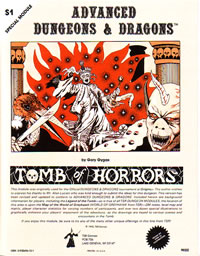
The trope began with Gary Gygax's
Tomb of Horrors.
Tomb of Horrors was an enormously influential adventure, one of the first modular adventures ever released. People tend to strongly divide between loving and hating it. It was designed to test the skills of overproud D&D players, but there's a lot of personality in it. The reader gets a sense of the builder's nasty sense of humor as well as their capacity for random mayhem.
Tomb of Horrors was quite successful. And with success came imitation. The next adventure in the "S" series was Lawrence Schick's
White Plume Mountain, which reinforced many of the concepts, including giving the players a riddle to help them figure out the mind-boggling traps that were laid for them.
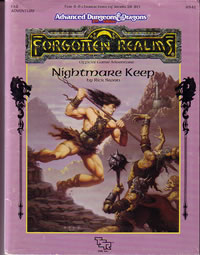
A further exploration of the theme was
Nightmare Keep. Like several vertions of the trope to come, this adventure set out to make a bigger and nastier
Tomb of Horrors . Included are the strange poetic traps, the same distinctive undead horror waiting at the end. However, it's a bit overblown, the traps rather self-consciously weird rather than traps for individuals to get themselves killed by being greedy or careless.
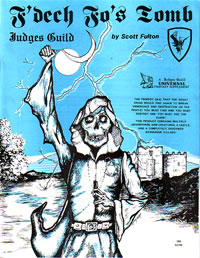
Other imitations include third-party adventures such as
F'Deck Fo's Tomb. I often champion third-party variations on a theme because individuals removed from the editorial control of a single entity (in this case TSR) often have wider mematic interpretation that brings something new and fresh to the trope. This is not the case here. With the adventure-writing in its infancy, some publishers seemed willing to publish anything. This adventure would never have gotten past the editors at TSR.
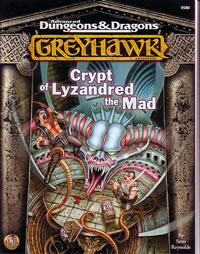
Rising RPG star Sean Reynolds wrote his own bigger, badder riddle tomb for second edition Dungeons and Dragons adventure
The Crypt of Lyzandred the Mad. Like many bigger versions of the original, this feels like the creator (Lyzandred, alternately Reynolds) is trying too hard. The riddles rely heavily on logic and word puzzles, sometimes straight-out asking the riddle, giving the feel of an enormous pop quiz. the
Tomb of Horrors' Acererak was trying to kill the characters. From a read-through, it feels like Lyzandred is grading them.
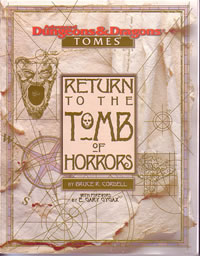
In the waning years of AD&D 2
nd ed, the
Return to the Tomb of Horrors mega-adventure was published. Both a sequel and an enormous expansion of the original, this gave the original
TOH a definite location as well as an ecology. Not only has the tomb attracted a cult of worshippers, but the builder's designs in creating such a deadly location come into very large, interdimensional view. Of course, it's up to the adventuring party to foil the mighty plot. The author, Bruce Cordell, did a good if not completely satisfying job with this expansion. It won best adventure for the year, and is certainly one of the most overarchingly grand adventures I've ever read.
Gygax went topped his own meatgrinder dungeon with Lejendary Adventures'
Necropolis, later converted to D&D 3rd edition by Necromancer Games. If the
Tomb of Horrors was a meat-grinder,
Necropolis is astonishing. The sophistication and resourcefulness of D&D players had increased, at least in Gary's opinion. However, it also shows a a definite change in Gary's style, and the expected style of play. Where
Tomb of Horrors is a location with no background,
Necropolis is set in a pseudo-Egyptian location, with a large number of encounters that contribute to a broad storyline leading up to the assault on the tomb of SetRahotep.
With the advent of third edition and the Open Game Licence, third parties were allowed to publish their own adventures in the D&D system. Unlike the earlier efforts, this time some extremely talented people got into writing adventures. Some of them wrote riddling trap tombs, and again the memetic mutation carries them to different yet interesating places, adding to the richness of the trope.
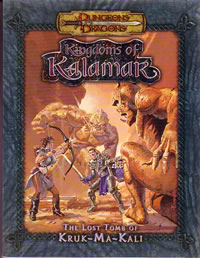
KenzerCo's
Lost Tomb of Kruk-Ma-Kali is one of my favorite meldings of the old meat-grinding trope with more in-depth playstyle. While the killing traps remain, the tomb is presented not only with an ecology surrounding it, it also has a political history. The end of the text also deals with the political and cultural repercussions of the players actions, allowing the adventure to become part of a larger tapestry. But this adventure made me wonder: if Kruk-Ma-Kali was basically a Hobgoblin Genghis Khan, why the blue frell did his followers dump his mortal remains into a supremely elaborate trap-tomb rather than paying for a resurrection?
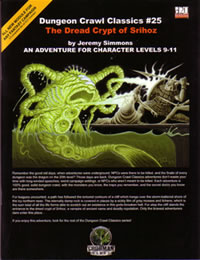 Dread Crypt of Srihoz
Dread Crypt of Srihoz is part of Goodman Games' Dungeon Crawl Classics series. These deliberately call back to adventures of first edition D&D, right down to a cardstock cover with the dungeon map printed in blue ink. Goodman's writers clearly know and love the dungeon tropes they are playing with. The
Dread Crypt is another deathtrap dungeon, but the writers have understood the need for the perception of a single guiding hand behind its construction. The tomb's locations serve a purpose, even if this will not be apparent to the adventurers, the cohesive design allows the Game Master to view it as an expression of the individual who built it. Of particular interest is the fact that it lampshades other riddling labyrinth lords by offering riddles that don't help the players at all. A very perceptive stroke.
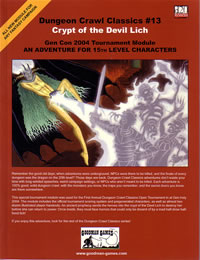
One of the earliest Dungeon Crawl Classics was produced as a direct homage to
Tomb of Horrors. Called the Dread Crypt of the Devil-Lich, it was a tournament adventure, just as the original TOH was. Imitating the older adventure, it contained many strange traps designed to test the adventurers' ability against deadly hangman's riddles. Its failing is that it does not feel like a cohesive adventure. Each trap is radically different from the other, never revealing the likes of the dislikes of the tomb's designer. Still, the adventure is very solid, and the climactic battle with the eponymous devil-lich looks both deadly and intriguing, especially after the party has waded through more than a dozen rooms of nightmare traps.
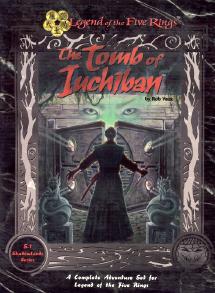
One of the best and most unusual homages to the
Tomb of Horrors is Tomb of Iuchiban for the Legend of the Five Rings game. TOH tributes seldom appear outside of DUngeons and Dragons, and L5R's Oriental setting is not one I would have thought that lent itself to the trope. Rob Vaux does so magnificently, however, creating an ever-changing maze of traps that range from simple but deadly to complex, magically weird meat grinders. This adventure is a real pleasure: well written, original, and cohesive.
And yes, now there is a fourth edition version of the Tomb coming out this month. Although 4th ed hasn't thrilled me so far (I haven't actually played since 2
nd), I think that may be the impetus for my most recent return to deathtrap tombs. I'm actually more interested in the Erol Otus-illustrated
Tomb of the Blind God (Goodman Games again).
This is my 'comfort' reading, imagining the D&D party trapped and besieged in a stone crypt loaded with traps and monsters. At best, they fire my imagination, wondering how characters (and players) would face the illogical hangmans' riddles they are presented with.
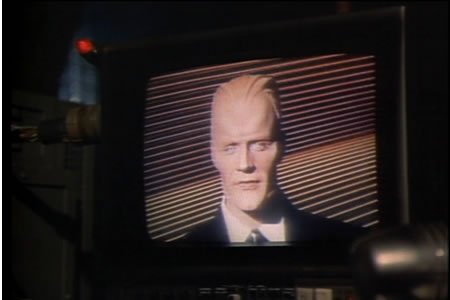
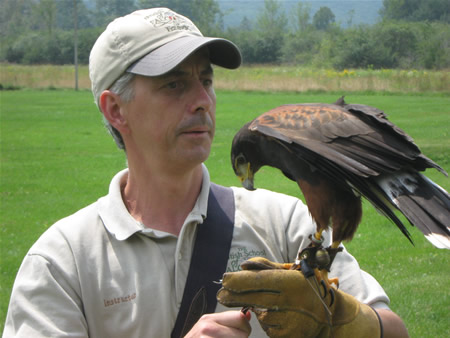
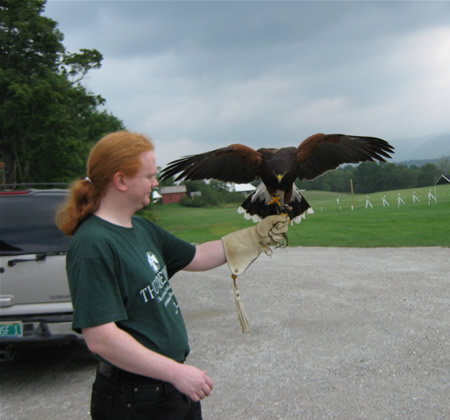
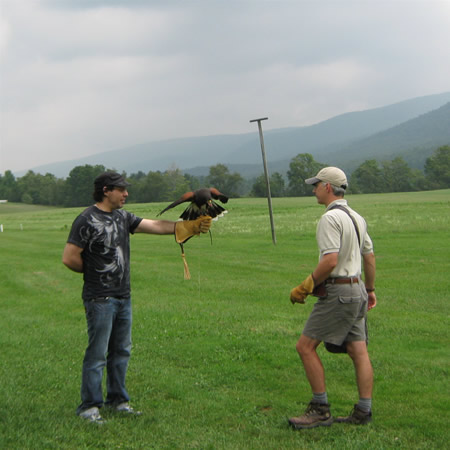
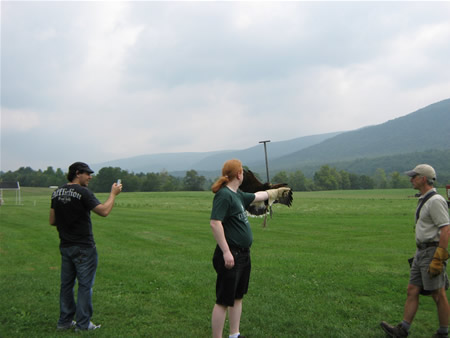
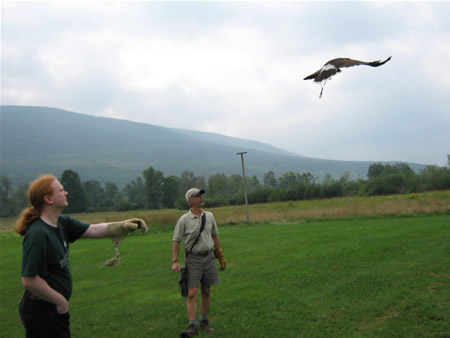

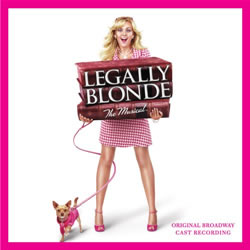
 The trope began with Gary Gygax's Tomb of Horrors. Tomb of Horrors was an enormously influential adventure, one of the first modular adventures ever released. People tend to strongly divide between loving and hating it. It was designed to test the skills of overproud D&D players, but there's a lot of personality in it. The reader gets a sense of the builder's nasty sense of humor as well as their capacity for random mayhem.
The trope began with Gary Gygax's Tomb of Horrors. Tomb of Horrors was an enormously influential adventure, one of the first modular adventures ever released. People tend to strongly divide between loving and hating it. It was designed to test the skills of overproud D&D players, but there's a lot of personality in it. The reader gets a sense of the builder's nasty sense of humor as well as their capacity for random mayhem. A further exploration of the theme was Nightmare Keep. Like several vertions of the trope to come, this adventure set out to make a bigger and nastier Tomb of Horrors . Included are the strange poetic traps, the same distinctive undead horror waiting at the end. However, it's a bit overblown, the traps rather self-consciously weird rather than traps for individuals to get themselves killed by being greedy or careless.
A further exploration of the theme was Nightmare Keep. Like several vertions of the trope to come, this adventure set out to make a bigger and nastier Tomb of Horrors . Included are the strange poetic traps, the same distinctive undead horror waiting at the end. However, it's a bit overblown, the traps rather self-consciously weird rather than traps for individuals to get themselves killed by being greedy or careless. Other imitations include third-party adventures such as F'Deck Fo's Tomb. I often champion third-party variations on a theme because individuals removed from the editorial control of a single entity (in this case TSR) often have wider mematic interpretation that brings something new and fresh to the trope. This is not the case here. With the adventure-writing in its infancy, some publishers seemed willing to publish anything. This adventure would never have gotten past the editors at TSR.
Other imitations include third-party adventures such as F'Deck Fo's Tomb. I often champion third-party variations on a theme because individuals removed from the editorial control of a single entity (in this case TSR) often have wider mematic interpretation that brings something new and fresh to the trope. This is not the case here. With the adventure-writing in its infancy, some publishers seemed willing to publish anything. This adventure would never have gotten past the editors at TSR. Rising RPG star Sean Reynolds wrote his own bigger, badder riddle tomb for second edition Dungeons and Dragons adventure The Crypt of Lyzandred the Mad. Like many bigger versions of the original, this feels like the creator (Lyzandred, alternately Reynolds) is trying too hard. The riddles rely heavily on logic and word puzzles, sometimes straight-out asking the riddle, giving the feel of an enormous pop quiz. the Tomb of Horrors' Acererak was trying to kill the characters. From a read-through, it feels like Lyzandred is grading them.
Rising RPG star Sean Reynolds wrote his own bigger, badder riddle tomb for second edition Dungeons and Dragons adventure The Crypt of Lyzandred the Mad. Like many bigger versions of the original, this feels like the creator (Lyzandred, alternately Reynolds) is trying too hard. The riddles rely heavily on logic and word puzzles, sometimes straight-out asking the riddle, giving the feel of an enormous pop quiz. the Tomb of Horrors' Acererak was trying to kill the characters. From a read-through, it feels like Lyzandred is grading them. In the waning years of AD&D 2nd ed, the Return to the Tomb of Horrors mega-adventure was published. Both a sequel and an enormous expansion of the original, this gave the original TOH a definite location as well as an ecology. Not only has the tomb attracted a cult of worshippers, but the builder's designs in creating such a deadly location come into very large, interdimensional view. Of course, it's up to the adventuring party to foil the mighty plot. The author, Bruce Cordell, did a good if not completely satisfying job with this expansion. It won best adventure for the year, and is certainly one of the most overarchingly grand adventures I've ever read.
In the waning years of AD&D 2nd ed, the Return to the Tomb of Horrors mega-adventure was published. Both a sequel and an enormous expansion of the original, this gave the original TOH a definite location as well as an ecology. Not only has the tomb attracted a cult of worshippers, but the builder's designs in creating such a deadly location come into very large, interdimensional view. Of course, it's up to the adventuring party to foil the mighty plot. The author, Bruce Cordell, did a good if not completely satisfying job with this expansion. It won best adventure for the year, and is certainly one of the most overarchingly grand adventures I've ever read. KenzerCo's Lost Tomb of Kruk-Ma-Kali is one of my favorite meldings of the old meat-grinding trope with more in-depth playstyle. While the killing traps remain, the tomb is presented not only with an ecology surrounding it, it also has a political history. The end of the text also deals with the political and cultural repercussions of the players actions, allowing the adventure to become part of a larger tapestry. But this adventure made me wonder: if Kruk-Ma-Kali was basically a Hobgoblin Genghis Khan, why the blue frell did his followers dump his mortal remains into a supremely elaborate trap-tomb rather than paying for a resurrection?
KenzerCo's Lost Tomb of Kruk-Ma-Kali is one of my favorite meldings of the old meat-grinding trope with more in-depth playstyle. While the killing traps remain, the tomb is presented not only with an ecology surrounding it, it also has a political history. The end of the text also deals with the political and cultural repercussions of the players actions, allowing the adventure to become part of a larger tapestry. But this adventure made me wonder: if Kruk-Ma-Kali was basically a Hobgoblin Genghis Khan, why the blue frell did his followers dump his mortal remains into a supremely elaborate trap-tomb rather than paying for a resurrection? Dread Crypt of Srihoz is part of Goodman Games' Dungeon Crawl Classics series. These deliberately call back to adventures of first edition D&D, right down to a cardstock cover with the dungeon map printed in blue ink. Goodman's writers clearly know and love the dungeon tropes they are playing with. The Dread Crypt is another deathtrap dungeon, but the writers have understood the need for the perception of a single guiding hand behind its construction. The tomb's locations serve a purpose, even if this will not be apparent to the adventurers, the cohesive design allows the Game Master to view it as an expression of the individual who built it. Of particular interest is the fact that it lampshades other riddling labyrinth lords by offering riddles that don't help the players at all. A very perceptive stroke.
Dread Crypt of Srihoz is part of Goodman Games' Dungeon Crawl Classics series. These deliberately call back to adventures of first edition D&D, right down to a cardstock cover with the dungeon map printed in blue ink. Goodman's writers clearly know and love the dungeon tropes they are playing with. The Dread Crypt is another deathtrap dungeon, but the writers have understood the need for the perception of a single guiding hand behind its construction. The tomb's locations serve a purpose, even if this will not be apparent to the adventurers, the cohesive design allows the Game Master to view it as an expression of the individual who built it. Of particular interest is the fact that it lampshades other riddling labyrinth lords by offering riddles that don't help the players at all. A very perceptive stroke. One of the earliest Dungeon Crawl Classics was produced as a direct homage to Tomb of Horrors. Called the Dread Crypt of the Devil-Lich, it was a tournament adventure, just as the original TOH was. Imitating the older adventure, it contained many strange traps designed to test the adventurers' ability against deadly hangman's riddles. Its failing is that it does not feel like a cohesive adventure. Each trap is radically different from the other, never revealing the likes of the dislikes of the tomb's designer. Still, the adventure is very solid, and the climactic battle with the eponymous devil-lich looks both deadly and intriguing, especially after the party has waded through more than a dozen rooms of nightmare traps.
One of the earliest Dungeon Crawl Classics was produced as a direct homage to Tomb of Horrors. Called the Dread Crypt of the Devil-Lich, it was a tournament adventure, just as the original TOH was. Imitating the older adventure, it contained many strange traps designed to test the adventurers' ability against deadly hangman's riddles. Its failing is that it does not feel like a cohesive adventure. Each trap is radically different from the other, never revealing the likes of the dislikes of the tomb's designer. Still, the adventure is very solid, and the climactic battle with the eponymous devil-lich looks both deadly and intriguing, especially after the party has waded through more than a dozen rooms of nightmare traps. One of the best and most unusual homages to the Tomb of Horrors is Tomb of Iuchiban for the Legend of the Five Rings game. TOH tributes seldom appear outside of DUngeons and Dragons, and L5R's Oriental setting is not one I would have thought that lent itself to the trope. Rob Vaux does so magnificently, however, creating an ever-changing maze of traps that range from simple but deadly to complex, magically weird meat grinders. This adventure is a real pleasure: well written, original, and cohesive.
One of the best and most unusual homages to the Tomb of Horrors is Tomb of Iuchiban for the Legend of the Five Rings game. TOH tributes seldom appear outside of DUngeons and Dragons, and L5R's Oriental setting is not one I would have thought that lent itself to the trope. Rob Vaux does so magnificently, however, creating an ever-changing maze of traps that range from simple but deadly to complex, magically weird meat grinders. This adventure is a real pleasure: well written, original, and cohesive. 
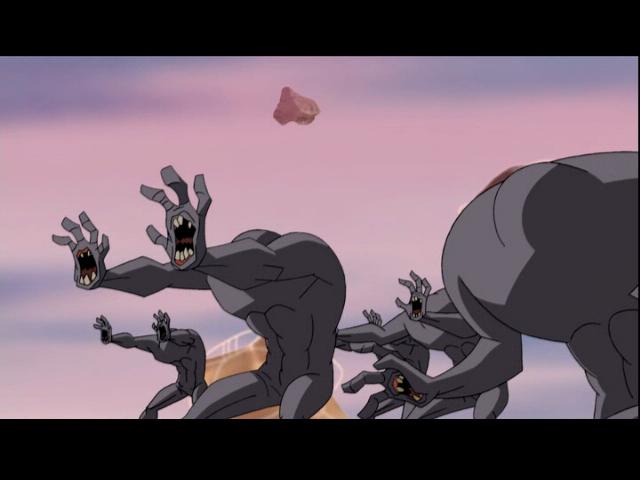 Now I'm going to start with the pictures. Some of Icthultu's defenders are gray, headless creatures with screaming mouths in their hands. Ramsey Campbell, are you paying attention?
Now I'm going to start with the pictures. Some of Icthultu's defenders are gray, headless creatures with screaming mouths in their hands. Ramsey Campbell, are you paying attention?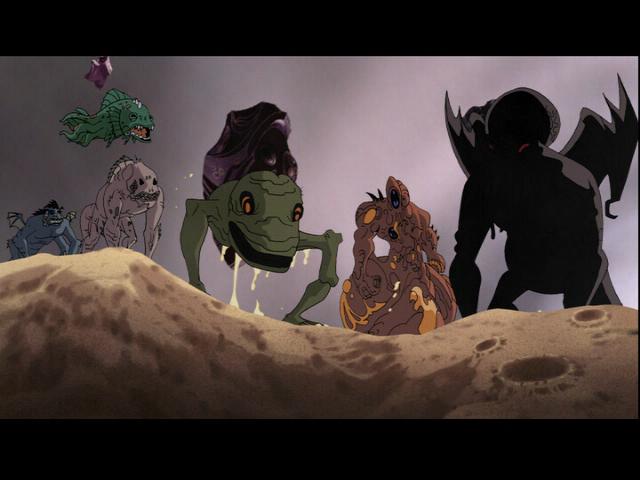 of the tentacled face of Icthultu glowering down on our heroes. Atheist Hawkgirl tells us that her Thanagarian people used to worship Icthultu, which gave them philosophy and agriculture in exchange for their souls. But the price was too high, and they stopped believing. They beat up some star-spawn (look at the right hand of the picture, that's practically Cthulhu in silhouette)
of the tentacled face of Icthultu glowering down on our heroes. Atheist Hawkgirl tells us that her Thanagarian people used to worship Icthultu, which gave them philosophy and agriculture in exchange for their souls. But the price was too high, and they stopped believing. They beat up some star-spawn (look at the right hand of the picture, that's practically Cthulhu in silhouette)  , and get right up to in Icthultu's grill.
, and get right up to in Icthultu's grill.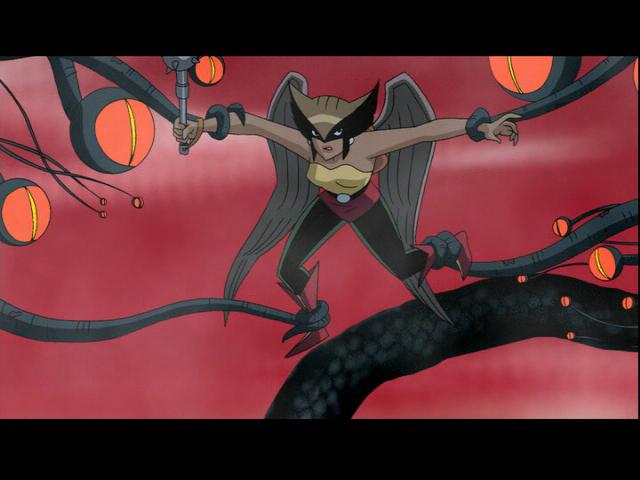 She's held spread-eagle (haw haw!) before the burning eyes of Icthultu, and banter is exchanged.
She's held spread-eagle (haw haw!) before the burning eyes of Icthultu, and banter is exchanged. 